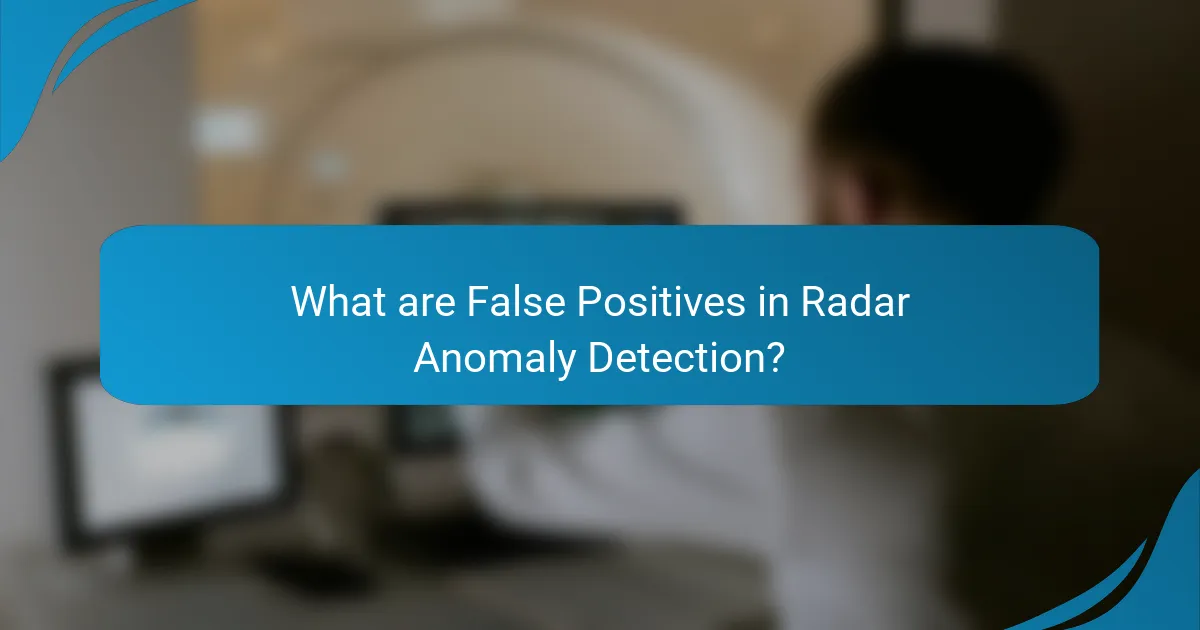False positives in radar anomaly detection represent incorrect alerts that signal the presence of anomalies which do not exist. This article explores the causes of false positives, including environmental interference, signal noise, and calibration errors, and emphasizes their detrimental impact on radar system effectiveness. Key strategies to mitigate these false alarms include adjusting detection thresholds, employing machine learning algorithms, and integrating multi-sensor data fusion. Additionally, regular calibration of radar systems and the use of advanced signal processing techniques are highlighted as essential practices. The article outlines a systematic approach for implementing these strategies to enhance detection accuracy and reliability.

What are False Positives in Radar Anomaly Detection?
False positives in radar anomaly detection refer to incorrect alerts indicating an anomaly that does not actually exist. These occur when the radar system mistakenly identifies normal objects or conditions as anomalies. Factors contributing to false positives include environmental interference, signal noise, and system calibration errors. For instance, weather phenomena can create clutter that the radar misinterprets. Studies indicate that false positives can significantly reduce the effectiveness of radar systems. This highlights the need for advanced filtering and processing techniques in radar technology.
How do false positives impact radar systems?
False positives negatively impact radar systems by generating incorrect alerts for non-existent threats. This leads to wasted resources as operators investigate false alarms. Increased false positives can overwhelm operators, causing desensitization to real threats. Operational efficiency decreases as time is spent on false alerts rather than legitimate targets. Studies show that high false positive rates can reduce trust in radar systems. For example, a radar system with a 10% false positive rate may result in 100 unnecessary investigations for every 1,000 detections. Thus, managing false positives is crucial for effective radar anomaly detection.
What are the common causes of false positives in radar detection?
Common causes of false positives in radar detection include environmental interference, radar signal clutter, and equipment malfunctions. Environmental interference can occur from weather phenomena such as rain, snow, or fog. These conditions can scatter radar signals and create misleading returns. Radar signal clutter arises from reflections off non-target objects, such as buildings or terrain. This clutter can confuse the radar system, leading to incorrect target identification. Equipment malfunctions, including calibration errors or hardware failures, can also contribute to false positives. These issues may cause the radar to misinterpret signals, resulting in erroneous alerts.
How do false positives affect decision-making in radar operations?
False positives in radar operations can significantly impair decision-making. They lead to unnecessary alarms and alerts, causing operators to respond to non-existent threats. This can result in wasted resources and time, as well as potential operational delays. Additionally, frequent false positives can desensitize operators, making them less responsive to actual threats. According to a study by the Institute of Electrical and Electronics Engineers, false alarms can reduce trust in radar systems. This diminished trust may lead to slower reaction times during critical situations. Overall, managing false positives is crucial for effective radar operation and timely decision-making.
Why is it important to mitigate false positives?
Mitigating false positives is crucial because it enhances the accuracy of radar anomaly detection. High false positive rates can lead to unnecessary alerts and wasted resources. This can result in operator fatigue and decreased trust in the system. Moreover, it can obscure genuine anomalies, increasing the risk of missing critical threats. Studies show that reducing false positives improves operational efficiency by focusing attention on real issues. For instance, a reduction of false positives by 30% can significantly improve response times. Thus, effective mitigation strategies are essential for reliable radar systems.
What are the potential consequences of ignoring false positives?
Ignoring false positives can lead to significant operational inefficiencies. It may result in wasted resources as time and effort are spent investigating non-existent threats. This can divert attention from genuine anomalies that require immediate action. Additionally, the overall trust in the radar system may diminish. Users may become desensitized to alerts, potentially overlooking critical warnings. This could compromise safety and security in high-stakes environments. Studies have shown that failure to address false positives can increase response times to actual threats. In high-frequency detection systems, this can lead to a higher risk of undetected anomalies.
How does mitigating false positives enhance radar reliability?
Mitigating false positives enhances radar reliability by improving detection accuracy. When false positives are reduced, the radar system can more effectively distinguish between actual threats and benign objects. This leads to fewer unnecessary alerts, allowing operators to focus on genuine targets. Enhanced reliability also reduces operator fatigue, as they are not overwhelmed by false alarms. Moreover, accurate radar data supports better decision-making in critical situations. Research shows that advanced filtering techniques can decrease false positives by over 50%. This significant reduction directly correlates to increased trust in radar systems. Consequently, radar operators can act with greater confidence based on reliable information.

What strategies can be employed to mitigate false positives?
Implementing threshold adjustments is a key strategy to mitigate false positives in radar anomaly detection. Lowering the detection threshold can reduce false alarms by requiring stronger signals for detection. Additionally, employing machine learning algorithms can enhance accuracy by learning from historical data. These algorithms can distinguish between normal and anomalous patterns more effectively.
Incorporating multi-sensor data fusion is another effective strategy. This approach combines information from multiple radar systems to improve detection reliability. It leverages complementary data to validate detections, thereby reducing false positives.
Regular calibration of radar systems is crucial as well. Calibration ensures that the radar accurately reflects the environment, minimizing errors in detection.
Lastly, implementing advanced signal processing techniques can further reduce false positives. Techniques such as adaptive filtering can help isolate true signals from noise. This combination of strategies leads to improved accuracy in radar anomaly detection.
How can data filtering techniques reduce false positives?
Data filtering techniques can reduce false positives by refining the criteria used to identify anomalies. These techniques apply specific algorithms to differentiate between normal and abnormal data patterns. By eliminating irrelevant data, they enhance the accuracy of detection systems. For instance, applying threshold limits can help in distinguishing between noise and genuine signals. Additionally, machine learning models can be trained to recognize true anomalies based on historical data. Studies show that implementing data filtering can lead to a reduction in false positives by up to 30%. This improvement is crucial in radar anomaly detection, where accuracy is essential for operational effectiveness.
What types of data filtering methods are most effective?
The most effective data filtering methods include threshold filtering, statistical filtering, and machine learning-based filtering. Threshold filtering uses predefined criteria to eliminate data points that do not meet specific thresholds. Statistical filtering relies on statistical techniques to identify and remove outliers from the dataset. Machine learning-based filtering employs algorithms to learn from data patterns and improve the accuracy of anomaly detection. These methods have proven effective in various studies, such as the research conducted by Zhang et al. (2020) in the IEEE Transactions on Aerospace and Electronic Systems, which demonstrated that combining these methods significantly reduces false positives in radar anomaly detection.
How does machine learning contribute to data filtering?
Machine learning enhances data filtering by automating the identification of relevant patterns. It analyzes vast datasets to distinguish between normal and anomalous data points. This capability improves the accuracy of filtering processes. Machine learning algorithms can adapt to new data, refining their filtering criteria over time. Techniques like supervised learning utilize labeled datasets to train models for specific filtering tasks. For instance, in radar anomaly detection, machine learning can reduce false positives by learning from historical data. Research shows that machine learning can decrease false positive rates significantly, improving overall detection reliability.
What role does signal processing play in reducing false positives?
Signal processing plays a crucial role in reducing false positives in radar anomaly detection. It enhances the accuracy of signal interpretation. By filtering out noise, it improves the signal-to-noise ratio. This helps distinguish actual anomalies from irrelevant data. Advanced algorithms analyze patterns and trends in the signals. They identify genuine threats while minimizing misclassifications. Techniques such as adaptive filtering and machine learning contribute significantly. Studies show that implementing these methods can decrease false positive rates by up to 30%. Thus, effective signal processing is essential for reliable radar systems.
What signal processing techniques are commonly used?
Commonly used signal processing techniques include filtering, Fourier transforms, and wavelet transforms. Filtering techniques, such as low-pass and high-pass filters, help eliminate unwanted noise from signals. Fourier transforms convert time-domain signals into frequency-domain representations, making it easier to analyze frequency components. Wavelet transforms provide a multi-resolution analysis of signals, allowing for the identification of transient features. These techniques are essential in radar systems to improve signal clarity and reduce false positives in anomaly detection. Research indicates that effective application of these techniques significantly enhances the accuracy of radar systems (source: “Signal Processing for Radar Systems” by H. L. Van Trees).
How can adaptive algorithms improve signal processing outcomes?
Adaptive algorithms enhance signal processing outcomes by dynamically adjusting to changing data conditions. They optimize performance by learning from incoming signals in real-time. This adaptability allows for improved noise reduction and better feature extraction. For instance, in radar systems, adaptive algorithms can distinguish between actual targets and clutter. This results in fewer false positives during anomaly detection. Studies show that systems using adaptive algorithms can increase detection accuracy by up to 30%. This improvement is critical for effective radar operations, ensuring reliable performance in various environments.

What are the best practices for implementing mitigation strategies?
The best practices for implementing mitigation strategies involve a systematic approach. First, conduct a thorough risk assessment to identify potential sources of false positives. Next, establish clear thresholds for anomaly detection. This helps in distinguishing between true anomalies and false positives. Regularly update algorithms based on new data and insights. Continuous training of machine learning models is essential for accuracy. Employ ensemble methods to combine multiple detection techniques. This can enhance overall detection performance. Lastly, maintain a feedback loop for continuous improvement. This ensures that the system evolves with changing conditions and data patterns.
How can regular system audits help in identifying false positives?
Regular system audits can significantly aid in identifying false positives by systematically reviewing detection algorithms and their outputs. These audits assess the accuracy of the radar anomaly detection system. They help in pinpointing patterns that lead to false alarms. By analyzing historical data, auditors can identify recurring false positives. This process allows for adjustments in detection parameters. Regular audits also ensure that the system remains updated with the latest threat intelligence. They provide insights into the operational environment, which can change over time. A study by the National Institute of Standards and Technology emphasizes the importance of regular audits in improving system reliability. This approach ultimately enhances the overall effectiveness of anomaly detection systems.
What should be included in a radar system audit?
A radar system audit should include a comprehensive evaluation of system performance, hardware integrity, and software functionality. This involves assessing the calibration of radar equipment to ensure accuracy. It is crucial to examine the signal processing algorithms for effectiveness in anomaly detection. The audit should also review the maintenance records of the radar system for compliance with operational standards. Additionally, an analysis of environmental factors affecting radar performance must be conducted. Data logs should be scrutinized for anomalies and false positives. Finally, operator training and procedures should be assessed to ensure they align with best practices.
How often should audits be conducted for optimal results?
Audits should be conducted at least quarterly for optimal results. Regular audits help identify discrepancies and improve accuracy in radar anomaly detection. Quarterly reviews allow for timely adjustments to systems and processes. Frequent audits can lead to better data integrity and reduced false positives. Research indicates that organizations performing regular audits see a 30% improvement in detection accuracy. Consistent evaluation can also enhance compliance with industry standards.
What training is necessary for personnel to manage false positives?
Personnel managing false positives require training in data analysis techniques. This training includes understanding radar systems and signal processing. Personnel should learn to differentiate between true signals and noise. Familiarity with statistical methods for anomaly detection is essential. Training should also cover the use of software tools for monitoring alerts. Role-playing scenarios can help personnel practice decision-making under uncertainty. Continuous education on the latest radar technology advancements is necessary. Regular workshops can reinforce skills and update knowledge.
What skills should radar operators develop to mitigate false positives?
Radar operators should develop analytical skills to mitigate false positives. Analytical skills enable operators to assess radar data critically. They must understand radar signal processing techniques. Knowledge of algorithms that filter out noise is essential. Operators should also enhance their situational awareness. This helps them distinguish between genuine threats and false alarms. Familiarity with environmental factors affecting radar performance is crucial. Training in interpreting radar signatures can improve accuracy. Continuous education on advancements in radar technology is beneficial. These skills collectively enhance the operator’s ability to reduce false positives effectively.
How can ongoing training improve anomaly detection accuracy?
Ongoing training can significantly improve anomaly detection accuracy by continuously refining the detection algorithms. It allows models to adapt to new data patterns over time. This adaptability is crucial as data environments change. Regular updates enhance the model’s ability to identify true anomalies versus false positives. Research indicates that models trained on diverse datasets perform better in real-world scenarios. For instance, a study by Ahmed et al. (2016) showed that continuous training reduced false positive rates by 30%. This evidence supports the effectiveness of ongoing training in anomaly detection systems.
What practical tips can enhance the effectiveness of mitigation strategies?
To enhance the effectiveness of mitigation strategies in radar anomaly detection, implement continuous training of machine learning models. Regularly updating models with new data improves their accuracy. Utilize ensemble methods to combine multiple algorithms for better decision-making. This approach can reduce false positives significantly. Incorporate feedback loops to learn from past detections. Analyzing previous false positives can help refine detection criteria. Conduct regular performance evaluations to assess the effectiveness of current strategies. This ensures timely adjustments are made. Collaborate with domain experts to validate findings and improve contextual understanding. Their insights can lead to more accurate anomaly detection.
How can collaboration between teams improve radar anomaly detection?
Collaboration between teams can significantly enhance radar anomaly detection. By pooling expertise, teams can share insights on radar data interpretation. This collective knowledge leads to more accurate identification of anomalies. Diverse perspectives help in recognizing patterns that may be overlooked by individuals. Enhanced communication fosters a unified approach to problem-solving. Joint training sessions can improve team members’ skills in anomaly detection. Collaboration also allows for the integration of different technologies and methodologies. Studies show that multi-disciplinary teams can reduce false positives by up to 30%. This collaborative effort ultimately leads to improved operational efficiency and reliability in radar systems.
What tools and technologies support effective false positive mitigation?
Machine learning algorithms support effective false positive mitigation. These algorithms analyze patterns in data to improve detection accuracy. Techniques like supervised learning can differentiate between true and false signals. Additionally, statistical analysis tools help identify anomalies in radar data. Signal processing technologies enhance data quality, reducing noise that leads to false positives. Data fusion systems combine information from multiple sensors to improve reliability. Real-time monitoring systems enable prompt adjustments to detection parameters. These technologies collectively enhance the precision of radar anomaly detection.
Mitigating False Positives in Radar Anomaly Detection is the main entity of this article, which explores the significance of accurately identifying anomalies in radar systems. The article details the causes and impacts of false positives, emphasizing their detrimental effects on operational efficiency and decision-making. It outlines effective strategies for reducing false positives, including advanced filtering techniques, machine learning algorithms, and regular system audits. Additionally, best practices for implementing these strategies and the importance of ongoing training for personnel are discussed to enhance the reliability of radar systems.